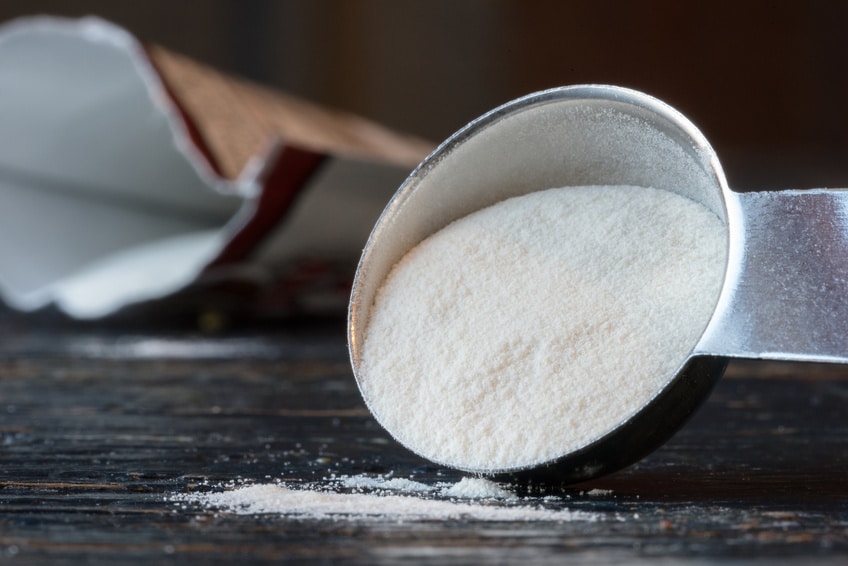Natural thickener

Unfortunately, cosmetic products cannot do entirely without thickeners and nowadays we use typically natural thickener. They ensure that the products always have an optimal consistency and increase the viscosity. For example, they make lotions more viscous and creamy, which makes them easier to apply and gives the skin a soft feel. Many manufacturers still rely on synthetic thickeners. Experts estimate that more than 10,000 tonnes of synthetic thickeners are used in the cosmetics industry every year. But only very few consumers know that these are often nothing more than liquid micro-plastic particles. The producing companies are very happy to use microplastics because the substances are extremely cheap to produce, they usually do not cause irritation or allergies, and they are not supposed to enter the human body when applied to the skin. For the environment, however, microplastics are very much a problem. The substances enter the environmental cycle via waste water, where they are difficult to degrade and cause massive damage. Responsible manufacturers know this and are increasingly using natural thickeners in modern cosmetics. These are also thickeners, but they are of natural origin and therefore do not cause any harm. However, many manufacturers still do not use natural thickeners, preferring instead to rely on the cheap plastic alternative. After all, a formulation with natural thickeners is more costly to develop and realise. However, for the sake of our environment and ultimately for the sake of our health, we should accept this additional expense. After all, it is out of all proportion to the devastating consequences that microplastics have for our planet.
Natural thickeners as a sensible and harmless alternative to synthetic thickeners
For several years now, researchers have been working tirelessly on the development of harmless thickeners. In the meantime, several natural thickeners have become established on the market that are no less effective than their chemical counterparts. Natural thickeners are mainly used in vegan cosmetics and natural cosmetics. The following is an overview of some proven natural thickeners:
Cellulose (also cellulose or E 460)
As the main component of plant cell walls, cellulose is even approved as a food additive with the European approval number E 460. The natural thickener forms the support structure in plant cells and is usually obtained from lignified plant parts. Cellulose is considered absolutely harmless. It provides a significant improvement in viscosity and is an ideal stabiliser. In the food sector, the substance is often found in dairy products made from cream, sauces and chewing gum. It can also be used in cosmetics as a natural thickener in a very versatile and flexible way. For example, it is often used in face masks and lotions.
INCI: cellulose
Function: viscosity-regulating, absorbent
CAS number: 9004-34-6
EINECS/EILINCS number: 232-674-9
Xanthan (also xanthan gum or E 415)
Xanthan gum is a completely naturally occurring polysaccharide derived from sugar-containing substrates. It has been approved as a food additive with the E number E 415 and is also an ideal natural thickener. The substance, which is made up of different individual sugars, looks like flour or powder in its pure form. Under the English name xanthan gum, it is already used in numerous cosmetic products: Examples are lotions, shampoos, and toothpaste, but also liquid soaps and mascara. The natural thickener xanthan gum is ideal for cosmetic use, because on the one hand it has a binding effect and thus ensures perfect cohesion of powder-like products, but on the other hand it also has an emulsifying effect, i.e., it enables the perfect combination of liquids that are actually immiscible. Xanthan gum is absolutely harmless as a natural thickener in cosmetics.
INCI: Xanthan Gum
CAS number: 11138-66-2
EINECS/EILINCS number: 234-394-2
Physical state: solid
Algin (also alginic acid, E 400 to E 405)
Algin is the structuring element of the cell walls in brown algae. In the extraction of iodine from marine algae, the natural thickener is a by-product. However, it is also extracted specifically from the algae for direct use in the food and cosmetics industry. In the EU, the substance and its sodium, potassium, ammonium, and calcium salts are approved as food additives with the numbers E 400 to 405. The natural thickener sodium alginate (E401) is used particularly frequently in molecular cuisine. Basically, alginates are not absorbed by the body and are therefore harmless. They have even proven their worth in medicine: for example, as a wound dressing, as a medicine against heartburn and as a biomaterial.
As a natural thickener, algin is an excellent gelling agent and a perfect emulsifier. It is used particularly frequently and very successfully in cosmetics for the production of gels.
INCI: Algin
CAS number: 9005-32-7
ATC-Code: A02BX13
Physical state: solid
Scleroglucan
Scleroglucan is a natural polysaccharide. The natural thickener is composed only of D-glucose molecules. These in turn are linked to each other by glycosidic bonds. Scleroglucan belongs to the group of so-called beta-glucans and is important in both medicine and cosmetics. In the cosmetics industry, scleroglucan can be used, for example, in hair care products and in various skin care products. In pharmaceutical products, the natural thickener is used in laxatives, in tablet coatings and generally to stabilise suspensions.
Gellan (also gellan gum or E 418)
As a polysaccharide, gellan is very often used in the food industry. The natural thickener is produced on a vegetable basis and with the help of special microorganisms on a sugar-containing nutrient medium. From a scientific point of view, gellan belongs to the polysaccharides and carbohydrates. Gellan is mostly used in the production of jams, marmalades, and confectionery. In pharmacy, the substance has been an ideal gelling agent for quite some time. It is preferably used in eye drops because it swells in the tear fluid to form a gel. In this way, the retention time of the medication in the eye is significantly improved. The cosmetic field, it can be used in creams, make-up, and face masks. In sun protection products, the natural thickener can have a stabilising effect and ensure an even distribution of the active ingredients.
INCI: Gellan Gum
CAS number: 71010-52-1
Physical state: solid (white-grey powder)
Pectin (also Pectin or E 440)
Pectin is a polysaccharide and occurs in the cell walls of fruits and plants. Red currants, lemon, and orange peels, but also apple pomace contain a particularly high concentration of this natural thickener.
Pectin is often used as a gelling agent in the production of jam. Internally, the substance is a proven remedy for digestive complaints such as diarrhoea. Among other things, many doctors recommend grated apples to combat diarrhoea in a natural way. Thanks to their extraordinary ability to form gels, pectins as natural thickeners are also an important ingredient in many creams, lotions, and other products in which gelling agents, thickeners or stabilising agents have to be used for various reasons. Their properties are used, among other things, to increase the stability and viscosity of emulsions and suspensions and to create various gels and pastes.
INCI: Pectin
CAS number: 9000-69-5
EINECS/EILINCS number: 232-553-0
Carrageen (also carrageenan or E 407)
Carrageenan is obtained from algae (red algae Eucheuma). Under the number E407, natural thickener is also approved for foodstuffs without quantity restriction. Carrageenan swells in water and is therefore popular as a natural gelling agent, emulsion stabiliser and viscosity regulator for use in cosmetic products. Carrageenan is very common in dry milk and soured milk products, ice cream, puddings, ketchup, sauces, and sweets. The natural thickener is ideal for making stable gels and viscous liquids. The Food and Agriculture Organisation of the United Nations (FAO) and the World Health Organisation (WHO) have classified it as safe with a maximum daily dose of 75 milligrams per kilogram of body weight. In cosmetics, this maximum value can hardly be reached anyway, because the natural thickener is only used in small quantities in toothpaste, for example.
INCI: Carrageenan
CAS number: 9000-07-1
EINECS/EILINCS number: 234-350-2
Properties: binding, regulates viscosity
Guaran (also Guar Gum or E402)
Guaran is a plant gum and the main component of guar gum. The substance is mainly used in the pharmaceutical, cosmetics, paper and food industries. It serves as a natural thickener, as an emulsifier and is very suitable for use in hair gel.
CAS number: 9000-30-0
Physical state: solid (yellowish-white powder)
Conclusion: Natural thickeners can perfectly replace synthetic thickeners
Cosmacon also relies on natural thickeners in the development of sophisticated natural cosmetics. We would be happy to develop innovative formulations for you that are perfectly tailored to your individual requirements. Just ask us!
Literature:
Ali A, Skedung L, Burleigh S, Lavant E, Ringstad L, Anderson CD, Wahlgren M, Engblom J.Int J Pharm. 2022 Feb 5;613:121370
Application of Xanthan Gum and Hyaluronic Acid as Dermal Foam Stabilizers.
Falusi F, Berkó S, Kovács A, Budai-Szűcs M.Gels. 2022 Jun 30;8(7):413
Xanthan Gum-Konjac Glucomannan Blend Hydrogel for Wound Healing.
Alves A, Miguel SP, Araujo ARTS, de Jesús Valle MJ, Sánchez Navarro A, Correia IJ, Ribeiro MP, Coutinho P.Polymers (Basel). 2020 Jan 4;12(1):99
Gering C, Párraga J, Vuorenpää H, Botero L, Miettinen S, Kellomäki M.Biomater Adv. 2022 Dec;143:213185
Oleuropein-Rich Gellan Gum/Alginate Films as Innovative Treatments against Photo-Induced Skin Aging.
Busto F, Licini C, Luccarini A, Damiani E, Mattioli-Belmonte M, Cometa S, De Giglio E.Molecules. 2023 May 25;28(11):4352
